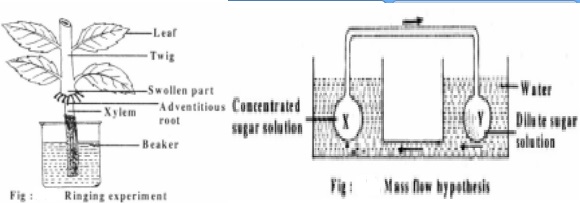Chapter: 11 th 12th std standard Bio Botany plant tree Biology Higher secondary school College Notes
Plant Physiology : Translocation of Solutes

Plant Physiology : Translocation of Solutes
In higher plants food is synthesised only in the green leaves which are the sites of Photosynthesis. From here the food is traslocated to the different parts of the plant in the soluble form. the process by which the synthesized food from the leaves is translocated to the different parts of the plant depending on their requirement is called translocation of food. the food materials in excess than the required amount are stored in insoluble form in the various storage organs and are translocated in solution or soluble form. Therefore thisis also referred to as translocation of solutes.
Direction of translocation
Translocation of food occurs in the downward upward and lateral directions.
Down ward translocation
Downward trnaslocation takes place from the leaves downwards to the stem, roots and storage organs.
Upward translocation
In some stages of plant life such as seed germination, emergence of new shoots from underground storage organs and development of buds, flowers and fruits, the food materials are translocated upward.
Lateral translocation
In certain parts of stem and roots food is translocated in lateral direction through medullary rays.
Ringing experiment to demonstrate downward translocation
Take a plant and remove all the tissues outerto xylem and pith in the form of ring at any place on the stem. The portion from where tissues are removed is sealed with melted wax. After 7 or 8 days the epidermis and cortex of upper portion of the ring become very much swollen and from this swollen part the adventitious roots emerge out. It happens because the food material translocated from the leaves does not pase through the ring and is stored in the upper portion.
Mechanism of Translocation
Following theories were proposed to explain the mechanism of translocation of solutes.
Munch's 'Mass Flow' Hypothesis
A few scientists believe that the soluble food material in the phloem move just like the blood which moves in the blood vessels. Based on this Munch in 1930 proposed a hypothesis according to which the soluble food materials in the phloem show mass flow. The fundamental idea behind this hypothesis is that the sugars synthesized by mesophyll cells of leaves increase the osmotic pressure (OP) of these cells causing entry of water into mesophyll due to absorption of water by the xylem cells of root. In other words a turgor pressure gradient exists through phloem, between the source which is the mesophyll cell and the sink which refers to regions of requirement.
As a result, the turgor pressure of mesophyll cells increases on the upper side which forces the solutes dissolved in water to flow en masse into the phloem of stem and finally into the roots.
This can be explained by a physical system. It consists of a glass tube bent at right angles. At the two ends differentially permeable membranes are tied. thus there are two osmometers x and y.
The osmometer x has concentrated sugar solution while y has dilute sugar solution. The two osmometers are kept in two separate water containers connected with each other through a tube.
Osmosis will take place and water enters both the osmometers x and y but the water entering 'x' is more and as a result of turgor pressure developed, water will move out of x and will enter y. Here the solute molecules are carried to y en masse with the flow of water explaining Munch's hypothesis.
The most important objection for this hypothesis is that it explains only unidirectional flow of solutes.
Importance of Munch's hupothesis
This forms basis of the principle of phloem loading and unloading.
Phloem loading is caused by movement of photosynthates from mesophyll to phloem. Unloading of phloem is caused by movement of photosynthates from phloem to other parts where required. This is the source-sink relationship.
Related Topics